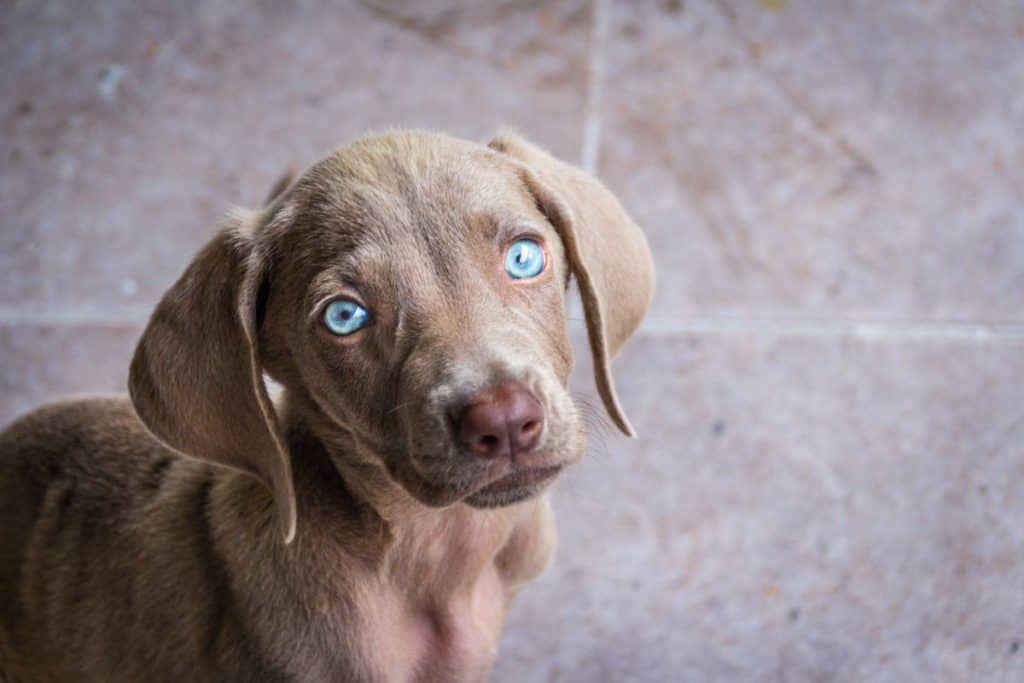The breed of Weimaraner dogs is very intriguing due to their exotic appearance, especially their deep-colored eyes. Throughout history, they have been known as excellent hunting canines and versatile companions. However, what’s fascinating about them is their color-changing eyes and how this transition occurs.
The beloved Weimaraner dog, also called “the grey ghost,” has an incredibly unusual eye color characterized by its hue of blue and its distinctive stripe pattern. It has been said that once they start maturing, their eyes change to a prominent shade of gray, green, and amber.
This article will review the nature of the Weimaraner’s eyes along with fascinating facts related to them, such as hereditary factors, eye health concerns, and care.
Do Weimaraner’s Eyes Change Color?

Weimaraners are known as “the silver ghost” for a reason. Based on a study conducted by the American Kennel Club or AKC, they acquired this peculiar nickname because of their incredibly silvery gray fur and mesmerizing light blue eyes. They also noted that they have a particular tiger-stripe pattern that contrasts with the shade of blue in their eyes. However, there are some questions concerning how they obtain this eye color and whether it remains constant.
The Weimaraner’s eye color initially appears as a striking shade of lighter blue with an interesting pattern. Regardless, as they mature and evolve, their eye color does the same and becomes permanent around six months of age. Once they become adults, the eyes may change to green, hazel, and most of the puppies’ eyes will turn brown. As they grow older, they begin to produce more melanin, which determines the color of their eyes, coat, and nose.
When Do Weimaraner’s Eyes Change Colors?
- In the first eight to fourteen days when they are newborn puppies, their eyes start by being closed. Once they begin to reveal themselves, they will show a beautiful shade of blue, usually uniform in color. Then after three to four weeks, their eye color will become more visible in the iris. During this time, you will start to see them changing very slowly.
- After three months, a deep turquoise shade of blue will be visible, and as they mature, they will start to produce more melanin in the iris, which will determine their final eye color.
- Finally, between six months and a year, the eye color will turn into a rare grayish-blue shade, green or amber, which is still striking and particular for this breed between six months and a year.
DNA of Weimaraners’ eyes
What determines blue-eyed dogs is a combination of inherited and genetic factors that can easily affect their eye color and appearance.
According to a recent study conducted by Cornell University College of Veterinary Medicine, there is a link between the blue eyes of Siberian Huskies and the repetition of canine chromosome 18. This study was based on a sample of around 6,000 dogs.
Moreover, this research suggests that different shades of blue eyes are caused by a genetic mutation or the duplication of the DNA sequence called “ALX4,” which involves the same chromosome 18. Furthermore, they determined that just one copy of the mutation caused blue eyes or heterochromia. This sequence is a determinant factor of the development of skin, hair, craniofacial characteristics, and eye color.
What Are Health Concerns Related To Weimaraner’s Eyes?
It is essential to know that Weimaraners have ocular health concerns that many owners of this breed should know. In the following sections, we will go over a brief list of common conditions they might face.
Entropion
The condition happens when eyelids roll inward, allowing lashes to make physical contact with the cornea. Consequently, this might end up with irritation in the eye. Symptoms can be observed within the dog’s first years of life, with either one or both eyes affected.
Early signs of entropion would be:
- Squinting or a lot of blinking
- Excessive tearing
- Eye inflammation
- Yellow/Green or white eye discharge.
Ectropion
In contrast to entropion, this condition causes the lower eyelid to roll down or outward, making the eyes look droopy. Additionally, it exposes the conjunctival tissue covering the eyeball and the inner surface of the eyelids. As a result, the cornea will get irritation from dust, pollen, or other environmental irritants. In severe cases, ulcers may form around the cornea. Preventing dryness of the affected area can be accomplished by using eye drops.
Both conditions are hereditary, genetic, and very common in this breed.
Distichiasis
This condition is due to extra eyelashes that irritate the cornea. If this irritation is prolonged, it can lead to ulcers. The cause of it is still unknown, but it is a hereditary trait in this breed.
Symptoms might include:
- Squinting or blinking
- Excessive tearing
Corneal Dystrophy
The condition is a genetic ocular disease composed of three types called epithelial, endothelial, and stromal. It explains the degeneration of the corneal lining and can happen at any age. Some of the signs of this disease are:
- Swelling of the cornea
- Corneal Spasms
- Visual impairment (only in advanced cases)
Cherry Eye
The term refers to a condition in which the tear gland swells up and appears at the corners of the dog’s eyes. It can be itchy, and since this is also a hereditary condition, Weimaraners will likely get it eventually. If this is recurring, it may cause permanent eye problems.
Are Dogs with Blue Eyes Prone to Having Eye Problems?
It is well known that even if these dogs have lighter and beautiful eyes, they are susceptible to certain eye conditions. Let’s begin with the most common health concerns.
Sensitivity to bright lights and sunlight: This is because their iris has lower levels of melanin pigment which means that it is less protected from harmful light rays. In addition, dogs with blue eyes might feel discomfort which may lead to serious eye problems.
Eye diseases: If the dog’s color gradually changes from a dark color to blue, this can signify eye diseases such as cataracts, glaucoma, or nuclear sclerosis. They can lose their sight due to cataracts, a condition that is more common in Weimaraners.
Do Weimaraners Have Poor Eyesight?
There isn’t enough research available to support this claim. Nevertheless, most owners of Weimaraner dogs are ready in case one of the ocular diseases mentioned previously occurs. Genetics and breed make them more likely to develop specific health problems as they age, so their vision might weaken, and their cognition might diminish. Additionally, their eye color makes them sensitive to other UV-related conditions.
Eye Care for Weimaraner
Overall, Weimaraner dog’s eye care consists of monitoring for any signs of ocular health concerns, cleaning and washing around their eyes carefully to prevent any irritations that may form. It is as simple as doing visual checks and routine maintenance. I used Arava Eye Wipes for my dogs to clean around their eyes. Make sure you check with your vet prior to using to get their recommendation.
If you see any of the symptoms mentioned above, we recommend you take them to the veterinarian, as they will be able to diagnose and provide the best treatment.
Conclusion
Weimaraner’s vibrantly blue eyes change as they evolve into adults. The color will transform into a gray, blueish gray, or light amber shade that will become permanent when they reach six months. Studies have been conducted that prove that certain factors such as DNA and hereditary conditions within the breed will determine the final eye color. It is prevalent for this shade to go darker once the dog starts to produce more melanin. As a result of their genetic makeup, they may face particular ocular health concerns such as entropium, ectropion, and cherry eye. Also, they might develop sensitivity to harsh light and some eyesight loss if they develop cataracts, which is typical for this breed.
